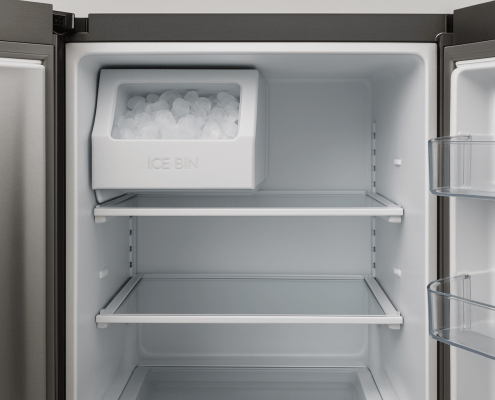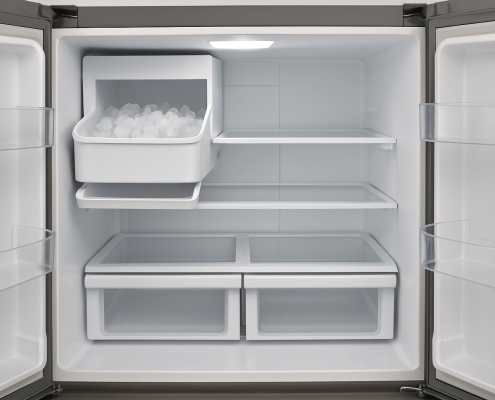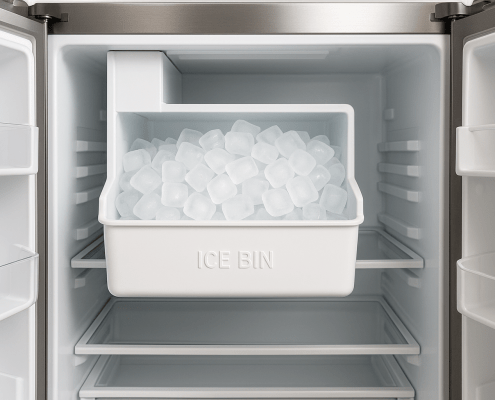How to replace dispenser cover 241679003 on a Frigidaire refrigerator
Steven E / Friday June 7, 2024
Is your Frigidaire refrigerator’s dispenser cover cracked or discolored? Don’t let a damaged cover lead to costly electrical issues—replace it yourself with ease! Dive into our step-by-step guide and watch the included how-to video to get your fridge looking and functioning like new again.
Looking for the right part? Enter your appliance model number below to find the exact match and get your appliance running like new again!
The dispenser cover is located on the front panel of a Frigidaire refrigerator and serves as a protective cover for the water and ice dispenser controls. Over time and due to regular use or accidental damage, the dispenser cover may break or become discolored. Breaks in the cover can allow moisture to seep into the control panel, which increases the chance of electrical issues.
If you need to replace the dispenser cover, you’ll be happy to know that it’s a relatively straightforward process that doesn’t require a professional service call. Let’s get started!
You can find a replacement dispenser cover here. If you need other replacement parts for your Frigidaire refrigerator, just enter your model number at AppliancePartsPros.com to find them. It’s that easy! Most orders arrive in just two business days, and we have thousands of guides to show you how to install your new parts.
What you need
- Phillips screwdriver
- Putty knife
- Heat gun
- New dispenser cover (make sure it’s compatible with your specific refrigerator model before installing)
Disclaimer: The specific tools required may vary depending on the model of your appliance and the type of fasteners used on it. Always consult the user manual or refer to any specific instructions provided by the manufacturer for the recommended tools for your appliance model.
Read more: Tool Maintenance 101: The Basics You Need To Know
Safety tips
When working on any appliance, remember to keep safety first. Here are some tips to keep in mind:
- Always power off and unplug your appliance or switch off the circuit breaker before you attempt any maintenance or replacement work. This keeps you safe by eliminating any risk of electric shock.
- If the appliance has recently been used, give it plenty of time to cool down before working on it.
- Turn off the water supply at the outlet before beginning repairs. Keep towels ready to catch any residual water in the system when removing parts.
- Take your time while working to prevent accidents and personal injuries. Rushing is the enemy of precision.
- Work in a well-lit area so you can see and access appliance parts.
- Keep your workspace free of clutter and other obstacles. Keep children and pets away from the work area.
- Never work on internal parts with wet hands. Make sure the work area is completely dry.
- Check the user manual to see if there are specific installation or safety instructions related to your appliance or replacement part.
- Be gentle when handling or removing parts. Excessive force might damage the appliance or cause personal injury.
- Wear insulated work gloves to protect your hands from sharp metal parts and debris.
- When working with wires, avoid touching any exposed wires or terminals. If you need to touch a wire, use a non-conductive tool or wear insulating gloves to prevent electrical shock.
- Always take photos or make a note of wiring terminals or other connections before disconnecting them to make reassembly easier.
Read more: How to clean and maintain your refrigerator’s water dispenser
How to change out the dispenser cover
Replace a faulty dispenser cover by following these steps:
- Unplug the refrigerator from the power outlet.
- Use a putty knife to remove the drip pan on the dispenser. Slide the putty knife under the drip pan on each corner and lift it out.
- You should see exposed screws that hold the cover at the bottom. Use a Phillips screwdriver to remove these screws.
- Push up on the dispenser cover to release the hooks at the back.
- Turn the cover and use the screwdriver to remove two Phillips screws that hold the switch.
- Remove the overlay from the cover.
- Use a heat gun to soften the glue at the back of the overlay. Be careful not to overheat and damage any plastic parts.
- Use the putty knife to start peeling off the old overlay from one corner. If the overlay is still glued on, use the heat gun again to soften the glue and continue peeling it off.
- Use the heat gun to soften the glue on the back of the new overlay for better adhesion.
- Carefully place the overlay on the new dispenser cover so that it’s aligned correctly. Press the overlay firmly, paying special attention to the corners and outer edges.
- Install the switch under the four tabs on the new dispenser cover.
- Secure the switch with screws and use the Phillips screwdriver to tighten them.
- Install the new cover onto the fridge and plug in the switch.
- Hang the cover on the top hooks by placing them through the openings on the door.
- Press the cover down to engage the hooks and secure it with three screws at the bottom.
- Slide the drip pan back in and align it, then press it into place.
- Plug the fridge back in and monitor it for the next several hours to make sure it’s working correctly.
Additional information
Thanks for reading! We hope this article helped you replace the dispenser cover on your Frigidaire refrigerator.
If you still need some replacement parts, grab your model number and head over to AppliancePartsPros.com. We offer over two million parts and most orders arrive in two business days. If you need some help with finding the right part or placing an order, you can contact our team at 1 (877) 477-7278.
While you’re waiting for your new part to arrive, you can explore our DIY blog and watch thousands of video tutorials on our YouTube channel.
Follow us on Facebook, Twitter and Instagram to see our latest repair guides!
With nearly a decade of experience in providing top-notch customer service regarding appliance parts and repair, Steven enjoys sharing practical advice, troubleshooting tips, and interesting information to help readers stay informed.





